Borussia Dortmund – Liverpool 1:1
Dortmund played host to Liverpool in one of the most highly-anticipated Europa League games in recent years. The talk of the game was largely based around Jürgen Klopp’s first return to Dortmund after leaving the side last year, however we saw a much more interesting story on the pitch in a tactically-intriguing match-up.
Liverpool Pressing
In the bigger games, Jürgen Klopp has a tendency to devise a surprise in his pressing scheme and usually to good effect. On his return to Dortmund, his side defended largely however in a shape which has become rather common since the German took over from Rodgers early in the season. For the most part, they looked to press between a 4-3-3 and a 4-5-1 with some variations in between. In some cases we saw more of a 4-3-3-0 with Origi covering the midfield as Liverpool attempted to block any passes into the centre.
The front three looked to block any passes into the Dortmund midfield and all three had the freedom to move out and pressure the ball when the situation deemed fit. Lallana and Coutinho could commonly move out to press the wider areas whilst Origi was able to apply pressure to the two centre-backs well from this 4-3-3 shape. These outwards movements allowed Liverpool to effectively pressure the Dortmund build-up and they reacted well to pressing triggers to move out and quickly close down the ball.
One of the biggest features of Liverpool’s defensive scheme was the central focus they adopted in this horizontally-compact 4-3-3 structure. With two narrow banks of three (and particularly so in midfield), Liverpool’s defensive strategy was largely based around their occupation of the central areas of the pitch as they attempted to force Dortmund away from the middle.
The three in midfield were rather man-oriented in their pressing and especially so with the two outside 8s in Milner and Henderson. The two English midfielders were energetic without possession and followed Castro and Mkhitaryan quite closely whilst coverage of Weigl was shared with the front line too. This often resulted in 4-2-4 variations during the Dortmund build-up in order to follow any dropping movements. In doing so, they looked to further restrict Dortmund’s ability to play through the middle by blocking access to the individual midfield players, inviting more build-up through the wider areas.
The result of Liverpool’s attempts to press was quite a chaotic game at times. Dortmund situationally struggled to establish control over the ball and play in the centre of the pitch was often unclean with quite a high tempo. The home side’s ability to control the rhythm of the game was restricted from their usual standards and their greatest attacking potential came through faster attacks when they managed to break the lines of pressure.
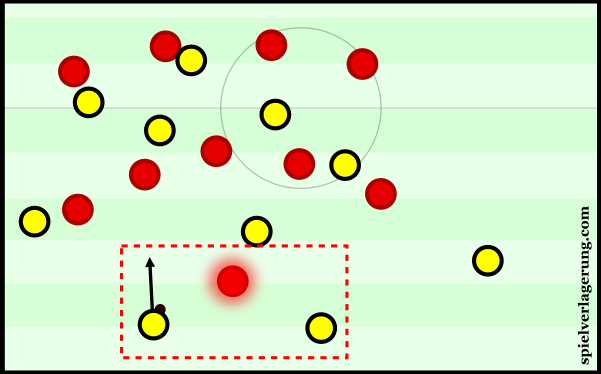
Defending in a 4-5-1, Origi became isolated and it was very difficult for him to create defensive access.
When acting deeper in a 4-5-1 shape, Liverpool’s pressing was much weaker and they found it difficult to establish defensive access in many scenes. Now acting in much wider positions, Lallana and Coutinho weren’t able to support Origi as much and the Belgian forward was often isolated in the first line of pressing. Bender and Hummels (as well as situationally with Weigl) were able to create a small and simple overload to give Hummels greater room to move forward.
Exploiting this space which wasn’t present against Liverpool’s 4-3-3 Hummels, who’s playmaking qualities are his greatest strength, looked to push up in the left half-space and give himself a position to better penetrate the midfield. With the 5-chain in midfield, Liverpool looked to emphasise a greater coverage of the width of the pitch with quite a flat and compact midfield line. However the spacing wasn’t optimal within the 5-chain and passing lanes were situationally opened for Hummels to use, as I will explain later in this article.
Dortmund’s Right-Sided Build-up
Not for the first time in this Rückrunde, Dortmund had clear issues when trying to build down the right side of their shape. This was a common sight as Liverpool like many before them looked to force the home side to build through Piszczek and more importantly, away from Hummels.
The co-ordination of the positioning between Piszczek and Erik Durm was a particular issue for Dortmund and was one of the key reasons why they failed to construct possession well down this side. Durm’s new role on the right of the midfield came about to facilitate a 3-chain shape with Mkhitaryan acting inside as an 8/10. In previous performances, Piszczek acted as the 3rd centre-back and would generally play in the right half-space as Dortmund built possession.
However in this game, the Polish defender acted as a more orthodox full-back and stayed closer to the wing, which was also occupied by Durm higher up. The result was that Dortmund had two players occupying the flank and it made for a weak connection between the two wide players which
If a straight pass is made from Piszczek to Durm, then he receives the ball not only on the touchline but facing away from goal in an extremely weak position. The young player has very limited options and it is very difficult to move the ball forward from here, so he often has to rely on making a pass deeper of which there are few options and thus predictable. As shown in this game, Durm doesn’t have the capacity as a player to beat his man in such a weak position and Dortmund could never really progress the ball through him.
The technical limitations of Durm on the right side was clear to see and he lost the ball on numerous occasions throughout the 45 minutes he featured. Obviously restrained by the lack of space due to the presence of the touchline, it was very difficult for him to maintain possession of the ball when pressed by the likes of Milner and Moreno. The playmaking abilities of Piszczek in deeper positions are also questionable and his passing from the first chain obviously aren’t up to the standards set by Mats Hummels.
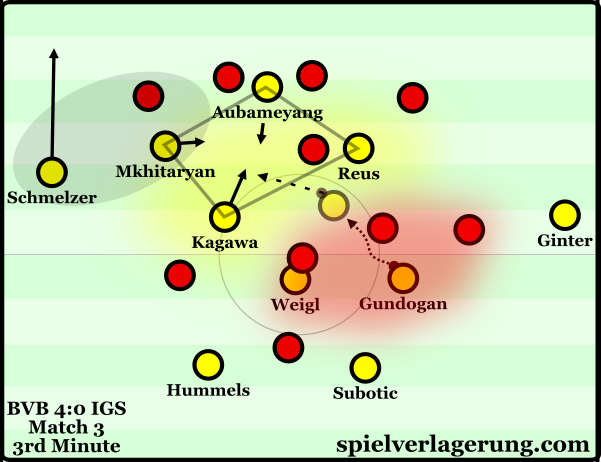
Gündogan’s ability to evade pressure is an extremely valuable attribute. This diagram is taken from my BVB analysis from late 2015.
It must also be noted the absence of Gündogan in these wide situations. There is no doubt that the midfielder is Tuchel’s best player and without his presence in the midfield last night, Dortmund struggled massively. His individual ability and pressing resistance was particularly sought after against the heavy man-oriented pressure of Liverpool whilst his playmaking ability was lacking in a number of opportunities the hosts’ had in the final third.
Dortmund have played a number of games without their star number 8 and have never looked 100% without him. However this game was probably the greatest indicator of what problems Tuchel will face he he doesn’t manage to keep a hold of Gündogan during the summer.
Dortmund’s Defensive Line
With Durm, Piszczek and Schmelzer selected alongside Sokratis and Hummels one would’ve expected to see a 5-chain which has been a common sighting in this year’s Rückrunde, however we saw a variation closer to a 4-man defensive line. At times it could appear as a 3-chain, as Schmelzer took on a more advanced position than his teammate on the right but quite often acted as part of the first line of Dortmund players.
The two centre-backs were often very close together and when they were building out from the back, both full-backs took on rather deep positions with Piszczek especially close to the first line of players. Because of these small distances, the defensive line appeared very tight and much narrower than we have ever seen from Tuchel’s Dortmund before. This spacing was one of the more interesting tactical features of the game and it had an important effect on Dortmund’s build-up.
There are many hints to the idea that this was a pre-planned tactic, as it was a consistent feature in Dortmund’s construction whilst if it wasn’t intentional, Tuchel would’ve had little trouble in ‘fixing’ this aspect of the defensive line.
With the narrow spacing amongst the back four, Dortmund limited their potential to stretch the opposition press and without a more stretched coverage of the width between the centre-backs. Although I’m far from certain as to Tuchel’s intentions in this tactic, it could potentially have been a more defensive-oriented approach in an attempt to reduce the tempo with the deep 2/4-chain in possession.
Another possibility is that he looked to draw out Liverpool’s press who would’ve had to pressure higher up and possibly with more numbers to re-establish access against a 4-chain. By inviting the away side to hold a higher block, Tuchel may have been looking to force his opponents to sacrifice some vertical compactness and stretch the distance between lines of players which Mkhitaryan took advantage of on a few occasions but to little profit.
At around the 25th minute of the game, Tuchel reverted his defensive line back to the aforementioned 3-chain in build-up. Schmelzer moved higher up whilst Piszczek took on a deeper position to create a defensive line with Bender and Hummels. This change brought about a more standard spacing across the defensive line as the half-backs occupied their respective half-spaces whilst Bender acted in the centre. Just minutes after the shift, Piszczek received the ball on the wing and was able to play an excellent penetrative pass to break the lines of a less-vertically compact Liverpool press.
https://twitter.com/TomPayneftbl/status/718413986916671488
Dortmund Penetrate the Half-Spaces
When they did manage to break Liverpool’s press, Dortmund were able to create some dangerous situations between the lines of the defence. They quite frequently targeted the half-spaces with penetrative passes from deep where Mkhitaryan in particular received many vertical balls down the right.
By drawing Liverpool’s press out within their own half, Dortmund were able to reduce the opposition’s vertical compactness and give Mkhitaryan more space to receive these passes between the lines. Their deeper circulation invited the opposition to push forward and challenge the build-up but this wasn’t always executed effectively, and gaps began to appear within the Liverpool shape. The man-oriented nature of Liverpool’s defence was used against them well by Dortmund as they used it to open the passing lanes into the half-spaces.
Another issue Liverpool had was in their use of cover shadows. The midfield used this strategy quite often to front the passing options and maintain a higher position whilst covering a player behind them. However due to the lack of access in their 4-5-1 and some intelligent movement from Castro and Mkhitaryan, these cover shadows were broken well by Dortmund. The deeper players commonly moved out of the shadow and occupied a space which could be accessed via a vertical pass before the Liverpool defender could readjust.
However despite creating numerous dangerous situations with Mkhitaryan or Reus receiving passes between the lines, they never were able to capitalise and create strong chances in the Liverpool box. They often struggled to find the crucial pass in these moments and a few of them resulted in weak shots from a central area outside of the box. In other scenes, the centre-back pairing of Lovren and Sakho were excellent and stopped the attacks with good coverage of passing options and at times some last-ditch tackles.
Liverpool’s Direct Game-Plan
In possession of the ball, Klopp elected for more of a counter-attacking strategy to the game, presumably looking to expose Dortmund’s susceptibility to counter-attacks which were a key issue through the hindrunde. He chose Divock Origi over Daniel Sturridge to lead the line, with the Belgian forward offering more explosive capabilities than his English teammate.
This ended up being an intelligent decision by the former-BVB coach as the striker offered well in transitions and was the target of numerous long balls to start quick attacks and potentially bypass the usually-excellent Dortmund counterpress. It was this approach which resulted in the opening goal of the game as a long ball played to Milner was misjudged by Hummels and the resulting flick-on played in Origi who made it 1-0 courtesy of a deflection off of Piszczek.
Liverpool’s attacking strategy to the game typified the ‘underdog’ approach Klopp made – something that he is clearly excellent at. The defensive strategy worked well to restrict a possession game which could be considered amongst the best in the world whilst when the away side did have possession, they created good chances from quick direct attacks and set pieces. During periods in the first half and just after Hummels’ equaliser, Liverpool enjoyed periods of dominance in which they could’ve scored many had it not been for some unbelievable goalkeeping from Weidenfeller.
Second Half Developments and Sahin’s Introduction
As the teams re-emerged after half-time, Nuri Sahin took to the field in place of Erik Durm whilst Joe Allen was introduced in place of Jordan Henderson. With this change, the hosts shifted into more of a 4-2-3-1 shape with Castro acting higher up in between Reus and Mkhitaryan who had now moved out to the right touchline. Nuri Sahin’s impact was effective as he formed a double pivot alongside Weigl, the midfielder provided a greater presence in these deep situations than Castro in the first half.
From a position deep in the Dortmund midfield, he allowed the home side to progress the ball better in construction by creating overloads around Origi. His movement away from the centre, often through the left half-space invited individuals from Liverpool’s press to move up and during these moments, Dortmund used their improved circulation to work their way around the press
Despite this shift in shape, Dortmund still often maintained their 3-chain in the defensive line which helped them keep a better circulation of the ball as they looked to break Liverpool’s press. Klopp’s team struggled to readjust their press at times to counter the shifts by Dortmund and the improved ball circulation meant that the home side had a greater capacity to progress the ball cleanly.
https://twitter.com/TomPayneftbl/status/718436449264267264
As the game wore on, Liverpool’s ability to press diminished as a result of fatigue as well as Tuchel’s changes to the deeper micro-structure of his team. The presence of Sahin as well as a clearer 3-chain gave them an improved collective pressing-resistance which was missing for large parts of the first half. Without the same levels of compactness and spatial coverage, Liverpool’s defence became vulnerable whilst Hummels’ playmaking stepped up another level.
The press wasn’t co-ordinated as effectively as previously and they weren’t able to stop passes into the centre at the same level. This weaker co-ordination could have possibly been a result of the adjustments by Tuchel, but also on a fitness level too. Whereas in the first half they moved out with good stability, they were now being bypassed more and more often through quick combinations from the deeper Dortmund players.
With Mkhitaryan on the wide right touchline it was more common to see Castro receive these passes in the second half, showing good movement and positional intelligence in a higher position to expose these gaps. However there was still a lack of an end product to most of these attacks, again hinting at Dortmund suffering without the influence of Gündogan in the centre of midfield.
Conclusion
After a strong performance from Liverpool, Klopp’s team deserved the 1-1 draw and at times were stopped only by the heroics of Weidenfeller from notching 3 or 4. Their excellent underdog game typified the nature of Klopp as they stopped a Dortmund who were albeit lacking Gündogan from playing their usual style. With an away goal under their belt, the game in England is set to be brilliant and if Klopp gets a similar performance out of his players it could help be the home side progressing. On the other hand, Ilkay Gündogan’s participation could be crucial for Dortmund’s side whilst they need to be more clinical once they break into the opposition’s third.


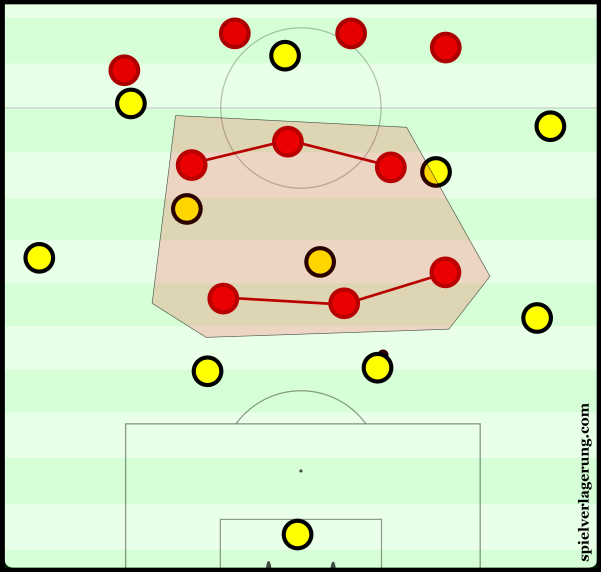


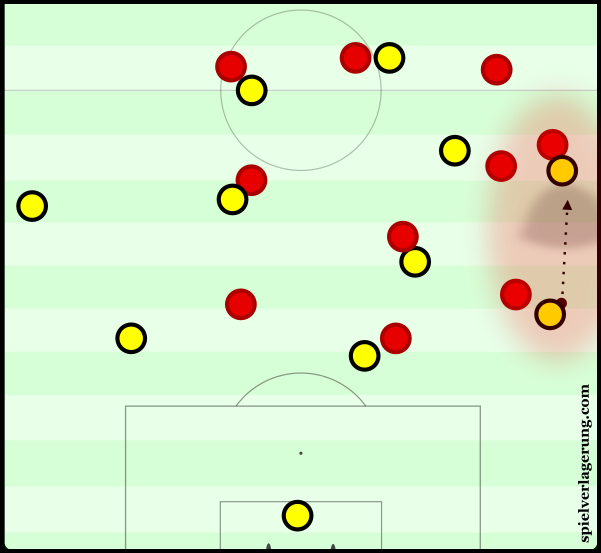

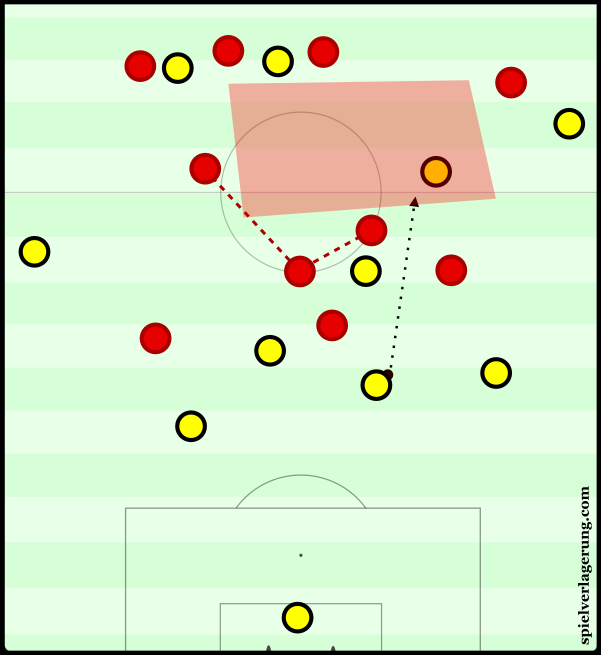
2 Kommentare Alle anzeigen
csp April 9, 2016 um 3:49 pm
Thanks for the analysis!
Had the impression we saw an extremly good example of all tactics lost if one = Dortmund shots that weak (Hummel’s header aside) on goal.
Mel Gibson April 9, 2016 um 10:50 am
Thanks for the analysis. Nicely written and with an excellent choice of clips, that underline the points made perfectly.
I am curious how tactics will change in the second leg and really hope to see another article here in a weeks time.